Irish Hill - A Neighborhood that Disappeared
Irish Hill was an area surrounding the industrial plants on Potrero Point where many of the Irish immigrant workers of the area lived, as well as a number of families that took in boarders. Because the working day was long and transportation poor, workers preferred to live within walking distance of their jobs, despite the noise and pollution of heavy industry.
This photo from the 1890s shows Irish Hill with the Union Iron Works in the background.
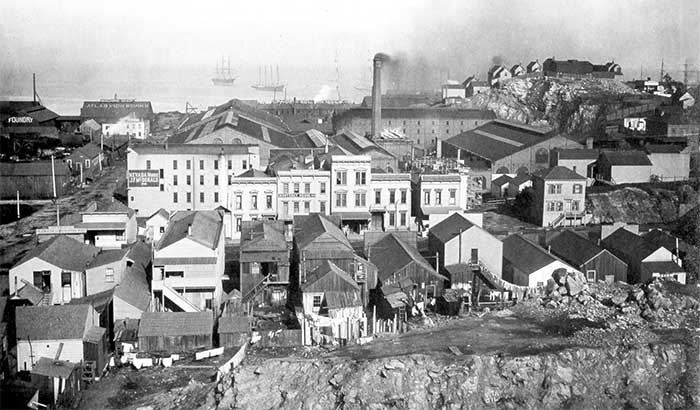
Irish Hill with Union Iron Works in background, 1890s. photo: San Francisco Maritime Museum Library
According to architectural historian Christopher VerPlanck,
Irish Hill was located in an area bounded by Illinois Street to the west, Pacific Rolling Mills/Union Iron Works to the north, San Francisco Bay to the east and San Francisco Gas & Electric Company to the south. It consisted of two separate areas: a district of approximately sixty shacks and cottages huddled on the crest of an outcropping of serpentine south of the shipyard and a compact district of approximately forty lodging houses on the flats surrounding the intersection of Illinois and 20th Streets.
In 1946 Billy Carr, a sheriff’s deputy who had been raised in Irish Hill, provided a colorful description of the scene:
In the early eighties it was mostly all hotels on Irish Hill. The Green House, run by Mike Farrell. The White House, run by Hans Rasmussen. Cash’s Hotel run by Jimmy Cole. The San Quentin House, run by Jim Gately. Gately took in the parolees from San Quentin and got them jobs in the rolling mills at the foot of the hill. There was Paddy Kearns’ Hotel, and outside the gas house was Mike Boyle’s steam beer dump…
In them days we never went to Morosco’s (a vaudeville house on Mission Street)…the shows were much better on Irish Hill, where the boys from one hotel would challenge the boys from another hotel and fight all Saturday afternoon in a hayrope ring outside Gately’s Hotel. Then we’d all go in and knock off steam beers for a nickel a piece…
You went up on Irish Hill when you got off work and you never left it until morning. Below it was Dutchman’s Flat (Dogpatch) where Dutchmen from the old country lived. The next hill, that’s Russian Hill now (Potrero Hill), was Scotch Hill, where the Scotchmen lived. The Irish came from Ireland, with a shaillalah stick and a bag on their shoulder, and a card telling them to go to work for the Pacific Rolling Mill. If there was no work there, they’d go to the gas house (San Francisco Gas Light Company). The Dutchmen came with work cards telling them to go to the sugar house (Western Sugar Refinery). The Scotchmen, all mechanical men, would go to work at the Scott Union Iron Works.
In them days, there was never a street paved. You went through the mud to school. If you wanted to go to Butchertown you walked a plank from Twenty-third Street to Arthur Avenue…But the war (First World War) came along, and the Government drove us off Irish Hill. Eight or nine hundred people used to live there.
The Blue Mud Wars
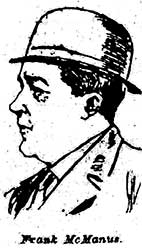
Billy Carr describes the rough and tumble of Irish Hill as lively and entertaining. He may have been too young to remember the roughest days of Irish Hill history in the late 1880s, when tough men like Frank McManus, "King of the Potrero," and the Welsh brothers fought bloody gang wars in the area. The bitter rivalries, evidently tied to the competition for the workers' rent and saloon trade, were written up in florid prose in the newspapers of the day, like this report in the San Francisco Examiner:
"J.C. Welsh asserts that McManus and his crowd came armed with knives and pistols and promptly proceeded to batter in his door, and when he went outside McManus confronted him with a pistol and fired point blank at his head [but missed]. The sound of the shot brought Sergeant Bennett and Policemen Dan Rearden and Eastman to the scene, from the station around the corner [on 20th], and when they arrived there were from eighty to a hundred men engaged on the sidewalk and knee deep in the mud of the street, assaulting each other with clubs and sticks."
These Irish Hill battles came to be called "the Blue Mud Wars" (probably so-called because the serpentine rock caused the muddy streets to look bluish).
Fire!
In addition to riots and flying bullets, fire was always a real danger on Irish Hill. (In fact the riot described above seems to have started with a small fire and charges of arson.) A major fire in November 1887 burned down over 30 structures. No one was killed, but several people came close to losing their lives as a lack of water prevented the firefighters from doing much until fireboats came and started pumping bay water to their hoses.
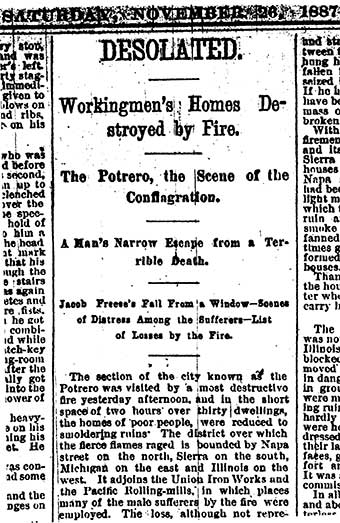
San Francisco Examiner, November 26, 1887
A newspaper account says that many of those left homeless by the fire were poor families. Most of these let rooms in their homes to the Irish workers. The existence of families in the area contrasts with the common belief that the area was solely occupied by workers, saloon keepers, and hotel owners.
Evidently, Irish Hill was rebuilt quickly after the fire, for the picture above shows the area less than a decade later.
Unhappy Neighbors
It has been said that the management of the nearby companies, such as Irving Scott of the Union Iron Works, were unhappy with the existence of the workers neighborhood adjacent to their plants and sought to clear them out. One reason cited is that the saloons served as breeding grounds for union organization (management was strongly anti-union). This may well be true, but reading the accounts of gang warfare and major fires suggests that the managers may have had many reasons to dislike the proximity of Irish Hill to their plants.
In any case, Irish Hill was not completely cleared and flattened until late in World War I, long after the Union Iron Works had been sold to Bethlehem. A photo from 1918 (looking south from the corner of 20th and Illinois Streets) shows some of the small houses and boarding houses still intact. They must have been cleared toward the end of the year.
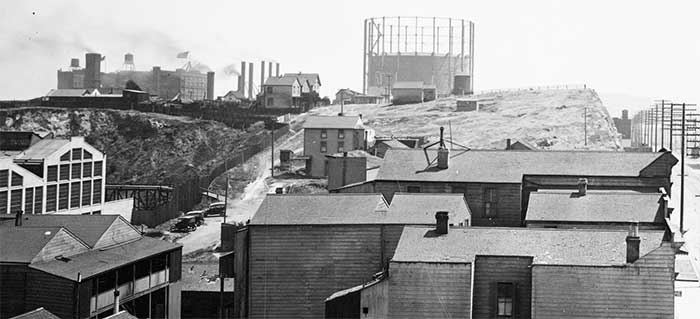
Irish Hill ca. 1918. photo: San Francisco Maritime Museum Library
Another photo from 1918 shows some of the businesses that occupied 20th Street, west of Illinois.
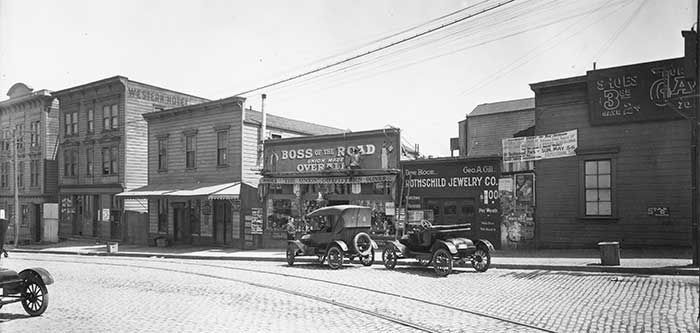
Irish Hill, 20th Street businesses, 1918. photo: San Francisco Maritime Museum Library
Bethlehem Shipbuilding seems to have used the area along Illinois Street as parking. It is now occupied by a storage rental company.

Site of Irish Hill businesses, now used as storage facility. photo: Ralph Wilson
Much of the hill itself must have been flattened in 1918, probably the last of the serpentine hills to be cleared and dumped in the bay. All that remains of Irish Hill today is a small rocky promontory near the intersection of Illinois and 22nd Streets. This remnant is partially on Port of San Francisco property and partly on land owned by P.G. & E.
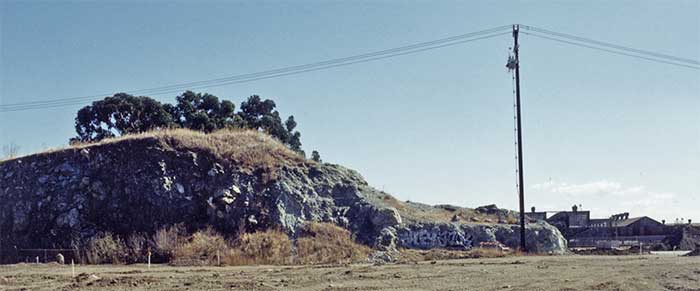
Remnant of Irish Hill today. photo: Ralph Wilson
Thanks to Sina Ghaemmaghami for his valuable research on Irish Hill, and to Peter Linenthal for locating the historical images.